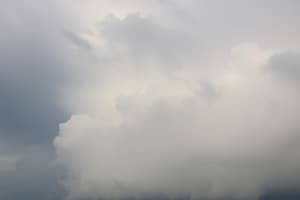Podcast
Questions and Answers
What is the primary reason for the formation of towering thunderstorm clouds in convectional rainfall?
What is the primary reason for the formation of towering thunderstorm clouds in convectional rainfall?
- Moisture-laden winds encountering mountains
- Heating of the Earth's surface during the day
- Cool air holding more water vapour
- Condensation of water vapour due to cooling of air (correct)
What happens to the air as it rises in convectional rainfall?
What happens to the air as it rises in convectional rainfall?
- It becomes less dense and cooler (correct)
- It becomes denser and warmer
- It becomes more humid and warmer
- It remains unchanged in temperature and density
Which of the following is an example of orographic rainfall?
Which of the following is an example of orographic rainfall?
- Rainfall in the rain shadow regions
- Monsoon rains in the Western Ghats (correct)
- Heavy rainfall in the Himalayan mountains
- Convectional rainfall in the equatorial region
What is the term for the areas that lie on the leeward side of the Western Ghats and receive less rain?
What is the term for the areas that lie on the leeward side of the Western Ghats and receive less rain?
What is the primary cause of orographic rainfall?
What is the primary cause of orographic rainfall?
Which type of clouds are formed in convectional rainfall?
Which type of clouds are formed in convectional rainfall?
Flashcards are hidden until you start studying
Study Notes
Convectional Rainfall
- Occurs in equatorial and tropical climates where intense heating of the Earth's surface takes place during the day
- Heating of the land causes the air above to rise, making it less dense and cooler
- As the air cools, condensation occurs since cool air cannot hold as much water vapour as warm air
- Towering thunderstorm clouds (cumulonimbus clouds) are formed, leading to heavy downpours when the weight of the water exceeds the cloud's capacity
Orographic Rainfall
- Caused by the relief or orography of the land
- Moisture-laden winds are forced to rise up along the slope of mountains or hills, resulting in cooling and condensation
- Heavy rain occurs when the air reaches the dew point and the clouds are no longer able to hold the water
- Examples of orographic rainfall include the Monsoon rains in India, particularly along the Western Ghats and the Himalayan foothills
- The windward side of mountain ranges receives copious rainfall, while the leeward side, such as Coimbatore, receives less rain and is known as a rain shadow region
Studying That Suits You
Use AI to generate personalized quizzes and flashcards to suit your learning preferences.




